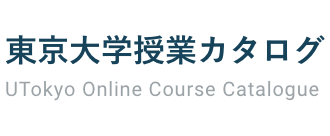学内のオンライン授業の情報漏洩防止のため,URLやアカウント、教室の記載は削除しております。
最終更新日:2024年10月18日
授業計画や教室は変更となる可能性があるため、必ずUTASで最新の情報を確認して下さい。
UTASにアクセスできない方は、担当教員または部局教務へお問い合わせ下さい。
最終更新日:2024年10月18日
授業計画や教室は変更となる可能性があるため、必ずUTASで最新の情報を確認して下さい。
UTASにアクセスできない方は、担当教員または部局教務へお問い合わせ下さい。
開発経済学
This is a course of development economics and policy analysis, where students learn how to apply economic and econometric tools to development issues in the real world. This course starts with a comprehensive review of the evolution of major development paradigms after the WWII: starting from Financing gap (1st generation), Structural adjustments/Washington consensus (2nd generation), and currently dominant 3rd generation paradigm which emphasizes “diagnostics” and “evaluation”. The two pillars of the 3rd generation paradigm are: Growth diagnostics (for growth strategy) and Impact Evaluation (for services delivery). The course then focuses on the two pillars of the new development paradigm and discusses how they can be applied for formulating development strategy with clear prioritization and designing projects with solid impact evaluation. Several case studies, which are mostly based on the instructor’s field experience as an economist in an international organization, are used to help students understand how the new approaches could be applied in the real development world. The course also examines how development organizations’ operational strategies have been changing with the evolving development paradigms.
Students are required to conduct a group case study of growth diagnostics, which becomes a key component of the toolkit for development organizations to formulate their operational strategy, to acquire practical knowledge to identify binding constraints, instead of the long list of reforms (or across the board linear push) in the Washington Consensus, for formulating growth strategies. The course also discusses technical challenges of the growth diagnostic approach from practitioners’ point of view.
After theoretical review of several impact evaluation methods, the course picks up two cases: conditional cash transfer in the Philippines and Mosquito net distribution in Kenya, to acquire practical knowledge of project design with impact evaluation and understand how impact evaluation can be used for effective poverty interventions.
This course requires students’ active participation in in-class discussions, and brave spirit to challenge, and even defy, conventional wisdom.
Students who have taken this course should be able to:
(1) understand how development paradigms have been evolving and how the changes in development paradigms have affected development organizations’ operational strategies;
(2) develop analytical skills to understand core development challenges in selected countries;
(3) understand new approaches in development economics, which apply the network theory in physics; and
(4) speak out own thoughts and ideas in the professional way in English.
(1) understand how development paradigms have been evolving and how the changes in development paradigms have affected development organizations’ operational strategies;
(2) develop analytical skills to understand core development challenges in selected countries;
(3) understand new approaches in development economics, which apply the network theory in physics; and
(4) speak out own thoughts and ideas in the professional way in English.
時間割/共通科目コード
コース名
教員
学期
時限
060320770
FAG-CE3E11L1
開発経済学
臼井 則生
月曜3限
講義使用言語
英語
単位
2
実務経験のある教員による授業科目
YES
他学部履修
可
開講所属
農学部
授業計画
1: Introduction—What will we learn in this course?
2: Ghost of financing gap—Harrod-Domar, Two-Gaps, and Revised Minimum Standard Model (RMSM)
3: Solow and beyond (Institutions)—Mankiw et al. 1992, Caselli 2004, and Acemoglu et al. 2001
4: Washington consensus, and seamless business practices of development organizations—"Everything is important” and “We are wise men” approaches (Rodrik 2006, and Easterly 2009)
5: New development (aid policy) paradigm—“Diagnostics” and “Evaluation”
6: Growth diagnostics—Algorithm to find (a few) binding constraints (Hausmann et all 2005)
7: An introduction to structural transformation and productivity (Usui 2012)
8: Diversification and upgrading—The Product Space (Usui 2012)
9: New industrial policy—Roles of government never die (Rodrik 2007)
10: Leapfrogging manufacturing?—Kaldor’s Laws, A. Lewis and modern services (Usui 2012)
11: How to measure attributable project impact? 1—Mosquito net distribution in Kenya (Cohen and Dupas 2010)
12: How to measure attributable project impact? 2—Philippines’ conditional cash transfer (RCT) (Usui 2012, Kremer and Holla 2009)
13: Recap—What did we learn in this course?
授業の方法
Lectures, Case studies (group work), and In-class discussion
成績評価方法
Case studies (30%), Participation in in-class discussion (20%), and Term Paper (50%)
教科書
None
参考書
• Mankiw, N.G., D. Romer, and D.N. Weil (1992), “A Contribution to the Empirics of Economic Growth”, The Quarterly Journal of Economics, 107(2):407-437.
• Caselli, F. (2004), “Accounting for cross country income differences”, NBER Working Paper 10828.
• Dollar, D., and W. Easterly (1999), “The Search for the Key: Aid, Investment and Policies in Africa”, Journal of African Economies, 8 (4): 546-577.
• Acemoglu, D., S. Johnson, and J.A. Robinson (2001), “The Colonial Origins of Comparative Development: An Empirical Investigation”, American Economic Review, 91 (5): 1369-1401.
• N. Usui (2012), “Taking the Right Road to Inclusive Growth: Industrial Upgrading and Diversification in the Philippines”, Asian Development Bank.
• Felipe, J., Kumar, U., N. Usui, and A. Abdon (2013) "Why has China succeeded? And Why it will continue to do so", Cambridge Journal of Economics, 37 (4): 791-818.
• Rodrik, D. (2007), One Economics, Many Recipes: Globalization, Institutions, and Economic Growth, Princeton University Press.
・Banerjee, A., and E. Duflo (2012), Poor Economics: A Radical Rethinking of the Way to Fight Global Poverty, PublicAffairs.
・Easterly, W. (2002), The Elusive Quest for Growth: Economists’ Adventures and Misadventures in the Tropics, MIT Press.
・Rodrik, D. (2006), “Goodbye Washington Consensus, Hello Washington Confusion? A Review of the World Bank’s Economic Growth in the 1990s: Learning from a Decade of Reform.
https://drodrik.scholar.harvard.edu/*****
・Hausmann, R., D. Rodrik, and A. Velasco (2005), “Growth Diagnostics”, John F. Kennedy School of Government, Harvard University.
https://growthlab.cid.harvard.edu/*****
・ Felipe, J., N. Usui, and A. Abdon (2011), “Rethinking the Growth Diagnostics Approach: Questions from the Practitioners”, Journal of International Commerce, Economics and Policy, 2 (2): 251-276.
https://pdfs.semanticscholar.org/*****
・World Bank, The Country Diagnostic Platform
https://www.worldbank.org/*****
・Usui, N. (2011), Searching for Effective Poverty Interventions: Conditional Cash Transfer in the Philippines. Asian Development Bank.
https://www.adb.org/*****
・Cohen, J., and P. Dupas (2010), “Free Distribution or Cost-Sharing> Evidence from a Randomized Malaria Prevention Experiment”, The Quarterly Journal of Economics, 125 (1), 1-45.
・Kremer, M., and A., Holla (2009), “Pricing and Access: Lessons from Randomized Evaluation in Education and Health”, in Cohen, J. and W. Easterly eds., (2009), What Works in Development? Thinking Big and Thinking Small, Brooking Institution Press.
履修上の注意
This course is offered only in English.
実務経験と授業科目の関連性
The instructor worked for Asian Development Bank (ADB), Manila, Philippines, for over 15 years (2000-2002 and 2005-2019): Pacific Department, Southeast Asia Department, Central and West Asia Department, and Economics and Research Department, where he managed economic monitoring and policy dialogues with over 15 developing countries in Asia and and the Pacific. He was also a resident policy advisor for the government of Indonesia during the Asian financial crisis (1998-2000).





 学部後期課程
学部後期課程

 マイリストに追加
マイリストに追加
 マイリストから削除
マイリストから削除


